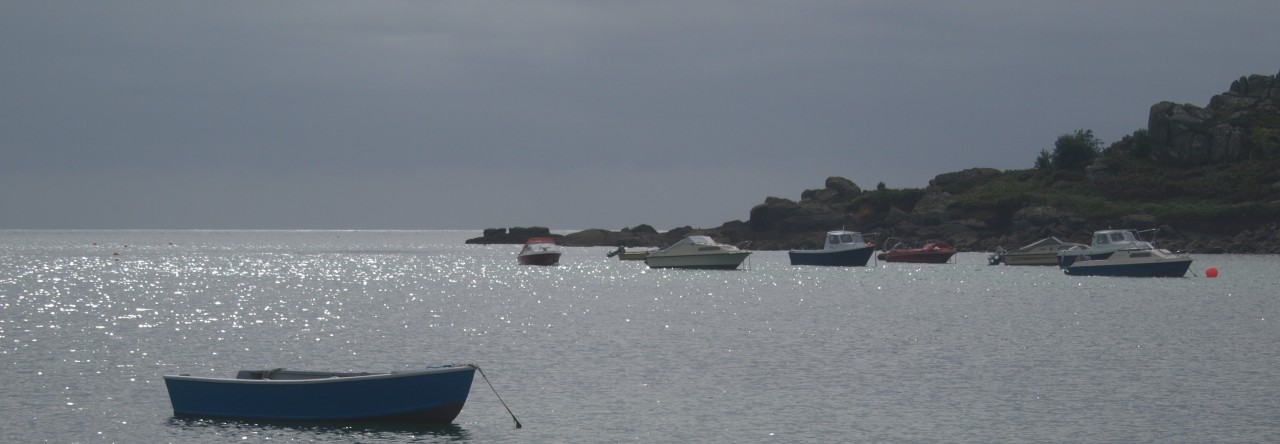Over breakfast on our second day on Caldey I was interested to discover from Angela, who manages the day to day running of St Philomena’s, how the monks and people who are not directly involved with the monastery rub along together. From what I had read of the Cistercian way of life it seemed to major on prayer, solitude and keeping a distance from outside world. Yet on a tiny island where everyone tends to bump into each other at the Post Office/shop and the monks certainly have to engage with the wider world in the selling of their perfume and chocolate I wondered how this worked out in practice. Although the monastery is a community in itself the monks and islanders do interact. Once a month there is a meal in which the island and monastery community join together and at Christmas a special Christmas party. Islanders also join the monks for worship at the Abbey. As with many islands life on Caldey in the winter months is very different, one of the main challenges being the cold and more especially the damp, the small and rather picturesque workers cottages are notoriously damp. There are 2 coal deliveries to the island a year and so unsurprisingly wood gathering is a particularly popular winter pursuit. St Philomena’s closes at the end of October and opens again at Easter during this time the island becomes far quieter. At the peak of the summer season over 1,000 visitors are drawn to the island and I suspect the monks and many of the island residents probably savour the solitude of winter and the chance to have the island back to themselves. Angela commented that living in a routine which involves much silence the monks often find the noise and pace of the outside world very alien to them. One brother having recently been involved in an accident on the island which involved a stay in hospital on the mainland found that 3 days away from the island and the monastery was quite long enough.
A conversation with Brother Titus.
We had met Brother Titus briefly on our arrival on the island but now it was good to have the opportunity for a more in depth conversation. In his role as guest master
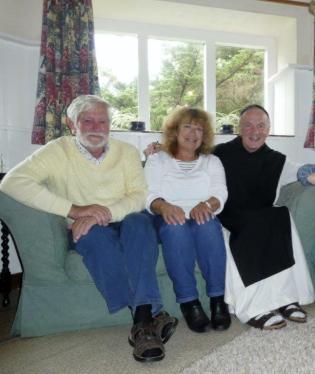
Brother Titus meets and greets the visitors who are staying on the island either within the monastery, where only male guests are permitted, or at St Philomena’s. Titus came to the retreat house each day for a prayer and a chat with visitors and to say prayers before the evening meal.
Born in the Netherlands Titus’s early career was in formula one racing. On taking holy orders he decided on the name Titus because he said, ‘like Titus in the New Testament, I went from one extreme to the other’. Titus came to Caldey partly because of his love of the island and the sea. To some extent monks can chose the monastery in which they will live but the final decision also depends on the community of brothers and the abbot. For a monk the decision/calling to a particular monastery is, I imagine, a little like a marriage, not to be entered into unadvisedly or lightly; but reverently, discreetly, advisedly, soberly, and in the fear of God. It must be agreeable to all parties, not only must the individual feel happy but also the community of brothers. Within the monastic tradition there is an important emphasis on stability so a brother can’t just hop randomly from community to community. In the 6th Century saint Benedict of Nursia founded 12 monastic communities at Subiaco, before moving to Monte Casino in Southern Italy. Benedict’s rule for his monks has become a touchstone for all monastic communities with its balance of gentleness, discipline and deep understanding of how a community of people living together over a long period works.
This is what Benedict says about stability:
‘When he [the new member] is to be received, he comes before the whole community and promises stability. The Rule of St. Benedict (Rule, 58).
This stability extends to the daily pattern of life. Here Titus explained the different emphasis in the life of Cistercians and Benedictines. Whilst the Benedictine motto is Pray and work ‘ora et labora’, the Cistercian way has a greater emphasis on liturgy and private study, ‘vacate and vidate’, be still and know is a guiding principle for Cistercians. This is not to say that the Cistercians don’t work, they certainly do, but the interior work of prayer and spirituality is regarded as of equal if not greater importance than daily routine tasks.
Cistercians are variously known as white monks from their white habit, Bernardines from St Bernard of Clairvaux and Trappists, a name that derives from a particularly austere Cistercian Abbey at La Trappe in Normandy.
The name Cistercian (French Cistercien), originates with the Latin name for the village of Cîteaux, near Dijon in eastern France. It was in this village that a group of Benedictine monks from the monastery of Molesme founded Cîteaux Abbey in 1098. The group led by Abbot Robert of Molesme felt that the Benedictine order to which they belonged had become too worldly and together with Alberic of Cîteaux and the English monk Stephen Harding he set about restoring the original purity of the Rule of St Benedict.
By 1111 the ranks had grown sufficiently at Cîteaux for a group of 12 monks to start a daughter house, a new community dedicated to the same ideals of the strict observance of Saint Benedict. The Cistercians were officially formed in 1112. The daughter house was built in Chalon sur Saône in La Ferté on May 13, 1113. In May of that year a charismatic young Burgundian nobleman named Bernard arrived at Cîteaux with 35 of his relatives and friends to join the monastery. A supremely eloquent, strong-willed mystic, Bernard of Clairvaux was to become the most admired churchman of his age.His entry into the monastery helped the rapid growth and development of the order. By the end of the 12th century, monasteries had been founded throughout France and into England, Wales, Scotland, Ireland, Spain, Portugal, Italy, and Eastern Europe.
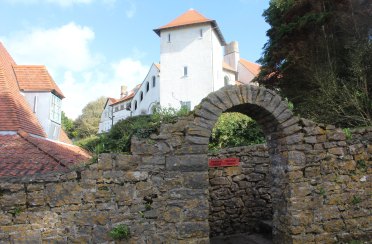
Today there are Cistercian monasteries throughout the world. The monks of Caldey Abbey belong to the Order of Reformed Cistercians. When they came to Caldey in 1929 they were restoring a long tradition of Cistercian monasteries on Wales. Before the dissolution of the monasteries in 1536 there were 13 Cistercian Abbeys in Wales. The monks of Caldey continue to follow the strict monastic lifestyle of poverty, chastity and obedience. They observe silence between the hours of 7a.m.to 7 p.m. and follow a strict routine of prayer, study and work.
Here is the daily timetable for a monk at the Caldey monastery
3.15 a.m. Rise
3.30 a.m. Vigils
Private prayer, meditation or study
6.30 a.m. Lauds and Con-celebrated Mass
Breakfast
8.50 Terce
Work or Study
12.15 Sext
12.30 Dinner
2.20 None
Work or study
5.30 Vespers
6.00 Supper
7.30 Compline
Retire
There is an impression that monks can be otherworldly and in some ways that may be so. However in my conversation with Titus I found him to be extremely perceptive and wise.
I wondered how he would feel about being quizzed by an Anglican Priest, and a woman at that, but I found him to be open and gracious and willing to engage with my questions. We spoke of the challenges of island life, of having to forgo life’s non-essentials but being compensated by the opportunity to go into the greater depths of the mystery and presence of God with no distractions. Also of having the opportunity to observe and ponder the power, beauty and wisdom of an island that is over 40 million years old.
When it came life within the monastic community and indeed life on the island in general, Titus spoke of the importance of respect, patience and the gift of forbearance. ‘Bow or you break’ he said. ‘The trees that survive longest in the forest are the ones that can bend.’ He spoke about the balance in his life between liturgy, study and nature, he clearly has a deep love of all three.
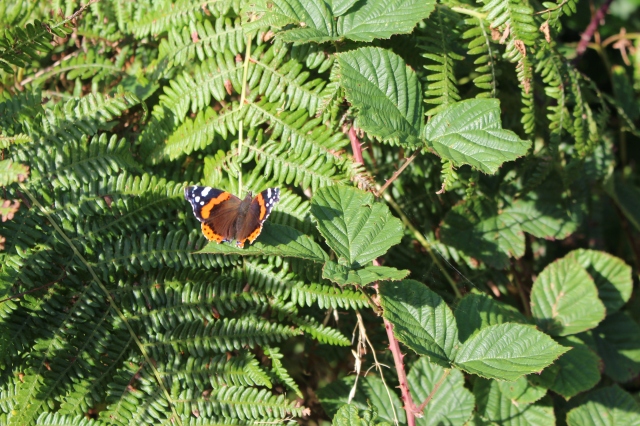
We found common ground when speaking about the Celtic approach to nature and how God is revealed in the beauty and indeed the rawness of the natural world. Titus also made an interesting distinction between the calling of a monk and the calling of a priest. The monk he said is called to a life of prayer an interior life, the priest is called to a life in the world. You can’t speak about a Catholic monk or a Protestant monk or a Buddhist monk, there are many monks and all share the same calling which is to pray.
Within the small monastic community on Caldey there are many gifted people, a musician, a baker, a linguist and a poet. In 1997 Father Richard Gwyn published a translation of the Psalms in Haiku an ancient Japanese form of poetry the Psalms In Haiku Form published by Gracewing Publications. Before entering the monastery Father David Hodges practiced as a solicitor and his books of poetry reflecting the monastic life of prayer in an island really struck a chord with me. As we watched the monks coming in to the Abbey for worship each day, I found myself looking at the faces and wondering about each man’s life story. Some may have felt the monastery was their life’s calling, some may have drifted in and found that it was the right place to be, others may have come here because they have found life has treated them harshly or they weren’t in tune with the pace of the world, all of these pathways led to Caldey.
Yet becoming part of a monastic community doesn’t always result in a happy ever after ending. Sometimes those with deep spiritual, mental and physical needs find themselves drawn to monastic life. Some time ago I heard the sad story of a man with a history of alcohol abuse who was drawn to the monastic life and during his years in the monastery seemed to have conquered his demons. For one night he left the monastery to celebrate a special occasion with friends he ended up getting rather drunk and having no home to call his own and far away from the monastery he fell asleep on a park bench and on a bitter winter night died of hypothermia.
There is something about the monastery that also has a feel of the desert, and as the desert fathers knew only too well, you may go to the desert imagining there will be no temptation but there it still lurks just the same only in a different form.
Monks are allowed time away from their monastery in order to take a break and to see their families. They have 3 sets of clothes: their monastic habit, their work clothes and their going away clothes. Just after we spoke Titus was due to take time away from the island to visit Hay on Wye with a friend searching for books for the Abbey’s library, from the twinkle in his eye I could see he was really looking forward to this.
Worshiping in the Abbey.
During our short stay on Caldey Alan and I joined in worship in the Abbey each day.
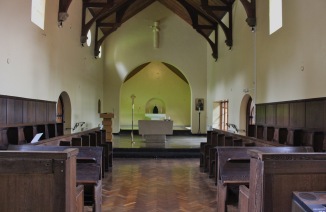
Our two fellow guests at the retreat house also joined in the worship. I can’t really imagine being a pilgrim in this place and not being part of the worshiping community. On entering the Abbey we were struck first of all by the beauty and simplicity of building and in particular the way the colour of the building changes with the light at different times of day.
On Friday, our first day we came to Compline. It was lovely to have the luxury of sitting together as a couple, listening to the words and the chanting of the monks and letting the mind roll back in a recollection of the events, the blessings and significant moments, the silences and conversations which had all been a part of our day.
Although in some ways we were outsiders every time we came to a service we were made very welcome. I have often heard the comments made that Anglican liturgy is too wordy with not enough silences, equally the criticism that in cathedral worship everything is either done for or to the congregation. Somehow here because the monks were inviting us into their space and their regular pattern of worship it seemed to feel very natural to simply just be there and share with them. One of the highlights for me was the little smile from the monks and sometimes a wave of the hand at the end of the service. Even though we’d been here for just a short while and had never exchanged conversation there was an unspoken fellowship of people meeting together for prayer.
Reading a little more about Caldey I discovered the thoughts of the present Abbot Father Daniel. Among his other duties he works in the bakery each day, he has written about what it means for him to be a Cistercian. I was really taken by his expression of universal truths relating to faith and life which seem to speak to many us of regardless of our different denominations and situations in life.
‘To be a Cistercian is just to get on with life as it presents itself from moment to moment, to try to be ‘here’. That can be quite a job. So often I think about yesterday and plan for tomorrow. In fact, what it comes to is the ‘here and now’, to be receptive and available. That is for me to open my heart for the presence of life, to the brother, to my own self, to be open for the presence of God, whose presence is active in ALL situations. All the practices through the day help me to open the door of my heart.’
[ref What it means for me to be a Cistercian today. by Father Daniel, Abbot of Caldey ]
Reading these words right now we are back in the hurly burly of parish life and ministry. Five months on from our Sabbatical, balancing all the demands and struggling to be present in the here and now makes me doubly aware of the value and wisdom of Daniel’s words and of our time on Sabbatical.
